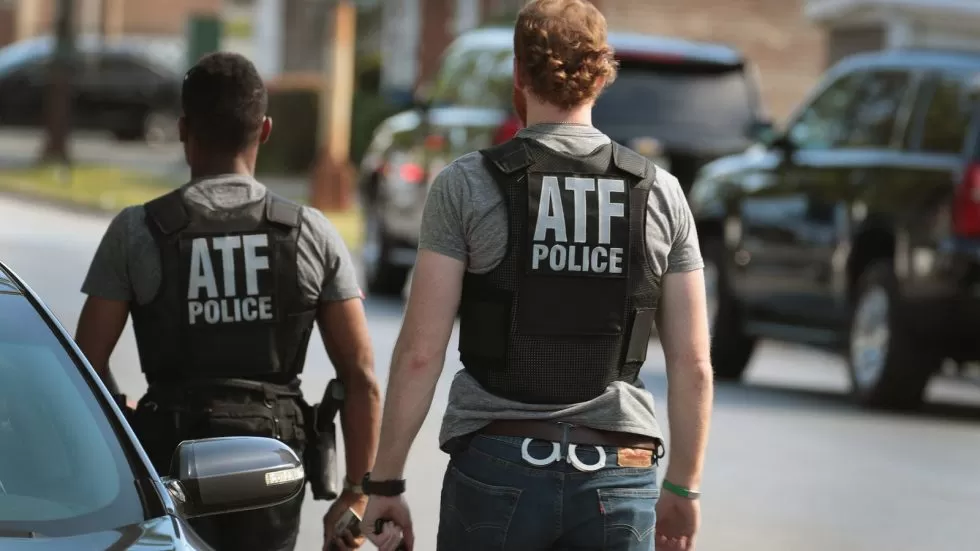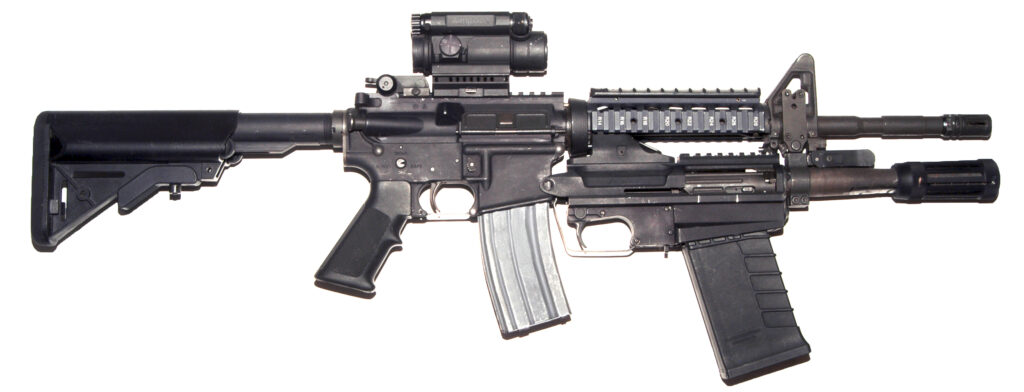The National Firearms Commerce and Trafficking Assessment, NFCTA: Crime Guns – Volume Two covers the 2017-2021 time period and collects data on states and cities interactions with firearms and attempts to categorize to track trends and provide information. There is a lot to unpack in this report and it is very informative.
NPR had this to say, however…
6 major takeaways from the ATF’s first report in 20 years on U.S. gun crime
Stolen guns, untraceable weapons and other deadly devices are becoming more prevalent in U.S. gun crimes, new federal data shows.
Advertisement — Continue Reading Below
Eh… hold on NPR. Before we make this claim too strongly we should look at 2022 and 2023’s data as it comes in. 2021 was a bad year. So before we start saying ‘more prevalent’ as a permanent trend, we should acknowledge that 2020 and 2021 had some extreme external stimuli related to the pandemic and government response to it. Those years were not business as normal.
Data from 2022 suggests we should see it land inbetween 2019 and 2020, at least that is what Chicago did.

Advertisement — Continue Reading Below
2023 in Chicago also appears to be continuing the reductions from the pandemic years, although we are still above average for the decade.
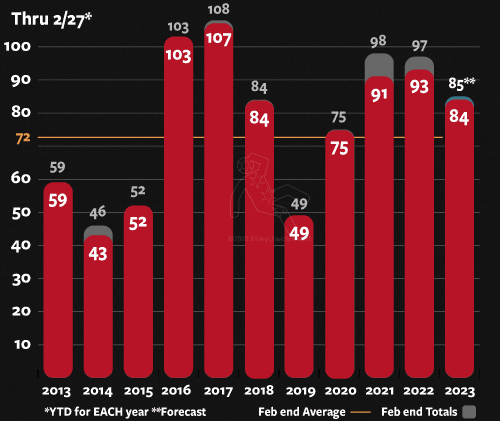
Back to NPR’s 6 takeaways,
Advertisement — Continue Reading Below
1. Legally purchased guns can change hands and end up being used in crimes
…
Well that one opens the list as broad and vague as possible. I wonder, can legally purchased alcohol change hands and end up being drunk before driving too? By a minor even? Spectacular analysis.
The ATF found that 54% of traced crime guns were recovered by law enforcement more than three years after their purchase. Those guns werelegally purchased, but were later used in crimes, the report indicated.
Advertisement — Continue Reading Below
Time to crime is a factor that is tracked, as well as locations, common FFLs, and as much information as possible to see where guns used in crime come from and what can be done to intervene. But the answer to that is one people don’t like. Crime guns come from a tremendous number of sources and represent a small fraction of firearms transfers in any given year. So, we can only do so much to stop them.
“Crime guns may change hands a number of times after that first retail sale, and some of those transactions may be a theft or violate one or more regulations on firearm commerce,” the ATF’s report reflected.
In other words, once it leaves the initial regulated retail chain of custody anything could happen. Sometimes the thing that happens is not legal and the gun is therefore used in a crime. We are again stating the obvious.
Advertisement — Continue Reading Below
“But what we know is from the large numbers of gun sales, there are lots of ways that legal guns end up in the hands of prohibited persons.”
*Sigh* We are again again stating the obvious.
Trace requests are up significantly since 2000, very true. But that 174% increase did not happen in a vacuum, it was not only the factor in the firearm space that increased in frequency.
Advertisement — Continue Reading Below
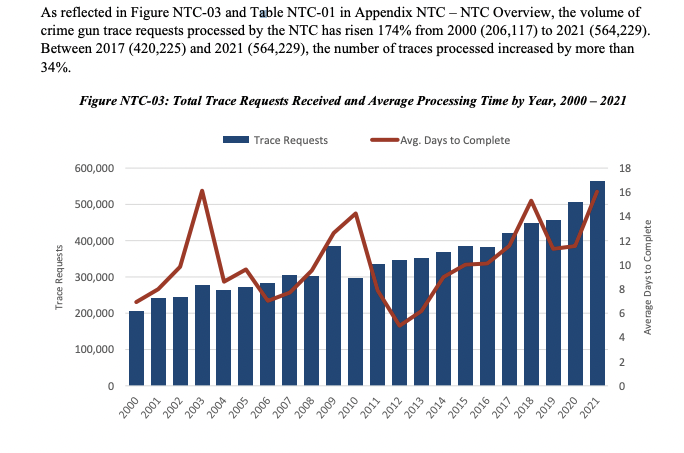
Now compare trace requests against NICS transfer requests.
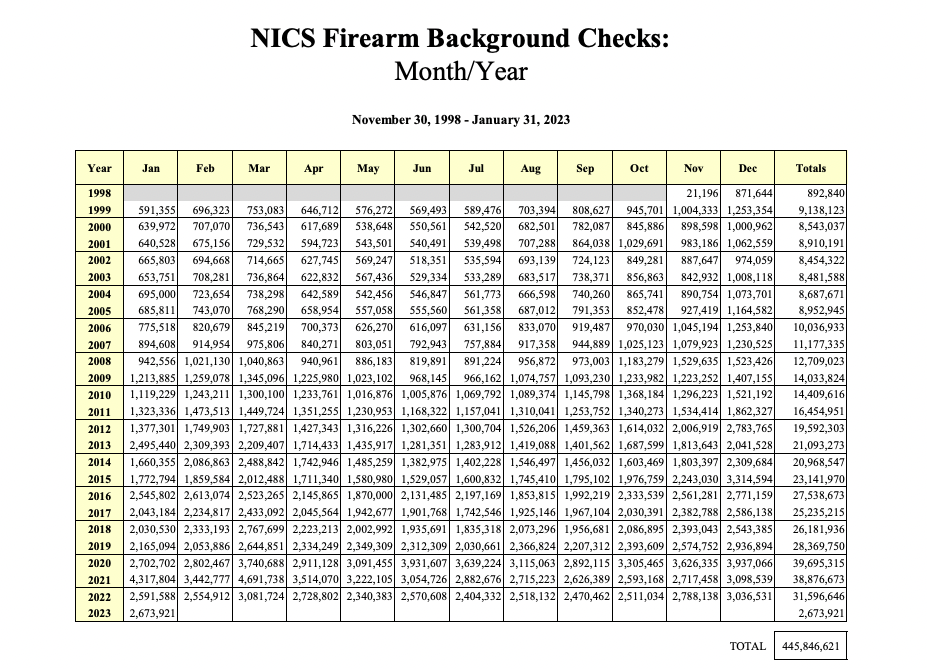
Advertisement — Continue Reading Below
2020 had 465% the volume of firearm transfer checks through FBI NICS that the year 2000 had, and 2021 was 455% the volume. So comparatively, the firearms economy in the nation grew more than twice as fast as the number of traces over the same timeframe. The rate of traces when compared to the number of transfers decreased.
During the period from 2000 to 2021, 77% (5,894,667 of 7,633,131) of all trace requests were completed. Since 2016, the trace completion rate has remained above 80%, the system is better and the market is full of newer post 68 firearms. Of the 23% of requests that were not completed, 1,738,464 trace requests in total, 366,281 (4.7%) requests were duplicates, 44,785 (0.58%) were stopped by requestor, 869,440 (11.4%) had invalid or inadequate firearm markings, and 457,958 (6%) were pre-GCA weapons and not required to be marked, as they were made prior to the 1968 Gun Control Act which began requiring specific marking.
During the time period, 2000 to 2021, a total of 401,545,091 requests were submitted to FBI NICS and denials (including 1998 and 1999) were only 2,039,507. So in the majority of the history of our national background check system and the mandate to use it by federal dealers, only 0.5% were denied the transfer. 1 in 200.
Advertisement — Continue Reading Below
Now two million denials sounds like a lot, two million prohibited ‘dangerous’ people who were stopped from getting a gun… from a licensed dealer at least.
For 2020 and 2021, the highest years for traces and worst in recent history for crimes, a total of 338,949 transfers were denied out of 78,571,988 requests. This means in the two worst years for violence recently, the denial rate was below average, at just 0.43%.
But of those denials in 2020 and 2021 there were 48,843 appeals were filed. Of those 48,843 appeals only 34,858 were sustained, meaning the false positive rate in NICS checks cases that are then appealed is a staggering 28.7%. Now to give FBI NICS the benefit of the doubt, let’s assume that every single case that didn’t file an appeal was an accurate denial to a prohibited person. That’s an absurd assumption but I’m going to give them it anyway, best case scenario as it were. The best case suggests NICS issues a false denial in 4.12% of cases, the actual rate is higher than that but is unlikely to match the abysmal 28.7% among appellants. It will be somewhere between.
Why did I deviate from the ATF report?
Context matters. 99.57% of background checks in recent NICS records are passed and the historical record maintains that rate, approximately 99.5%, throughout NICS operational history. These do not get referenced in the ATF report and a more negative image of the general outlook gets portrayed by NPR commentary than the ATF report manages to convey.
Lindsay Nichols, policy director with the Giffords Law Center to Prevent Gun Violence, told NPR: “This report is a major development for ATF in terms of their transparency.” NPR quotes a few paragraphs above the current section, and that is true. But that transparency also points out inefficacies and non-problems as often as where the ATF is doing work.
2. More than 1 million guns were stolen from private citizens from 2017 to 2021
A huge way those legally purchased firearms get into the hands of criminals is through theft, the ATF said. In five years, there were more than 1 million firearms stolen from private citizens and reported to authorities.
Criminals will commit crime to arm themselves for crime? Interesting.
There’s a caveat here, however. Federal law doesn’t require individual gun owners to report the loss or theft of their firearm to police. And while local laws vary, it also isn’t a requirement in many states to report a stolen gun, either — so the number of gun thefts could be much higher.
Do we have an estimate of how much higher?
In 2016, the U.S. Bureau of Justice Statistics National Crime Victimization Survey provided data that citizens reported about 75% of firearm thefts to a LEA that, presumably, reports all thefts to the FBI NCIC.20 As such, the annual total number of stolen firearms in the U.S. can be estimated at approximately 266,000 per year during the study period.
So we actually have a good estimate that is probably 1.35 million thefts and 25% go unreported.
Regardless, Nichols, with Giffords, called this number “horrifying.”
I would use the more tempered ‘concerning’, you’ll see why below.
“It shows that we really have a serious problem with guns that are not being stored safely in order to prevent this,” she said.
Do we? Is a firearm theft automatically a case of negligence and improper storage?
ATF and FBI data documented approximately 215,000 guns stolen and reported to LEAs annually during the study period. Most stolen firearms originated from thefts from private citizens’ homes and vehicles.
The ATF does not have the same data on private thefts as they do the smaller number of FFL thefts. Private thefts account for 96% of stolen firearms and most private thefts involved a single firearm. We do not have adequate data on storage methods so we cannot say with any certainty that they were stored ‘unsafely’ just because they were stolen.
What obligation are we implying on an owner must take on for criminal damage to their property to constitute safe storage? Locked doors and windows? Stored out of site? Additional locking room? Where do we stop blaming the victim and blame only the thief?
From 2017 to 2021, LEAs reported 770,642 private theft incidents involving 1,026,538 firearms to the FBI NCIC (Figure PT-01). The number of reported private firearm theft incidents did not change significantly during the study period. Throughout the study period, most of these private theft incidents involved a single firearm. –Part V Pg 19

Thefts from private citizens account for nearly 96% (1,026,538) of all firearms reported stolen from 2017 to 2021. About 60% of private theft incidents (480,542) occurred in the South, and Southern states were more likely to have higher rates of private thefts per 100,000 population. About 71% (729,560) of firearms reported stolen from private citizens were pistols and the most prevalent caliber was 9mm (38%; 392,876). From 2017 to 2021, there were 296,787 firearms recovered that were associated with a private theft incident. When firearms are recovered, they tend to be recovered in the state in which they were stolen (92%; 271,916).
There are enough firearms stolen on an annual basis to arm all offenders who commit firearm homicides, firearm assaults, and firearm robberies each year.22 However, less than 5% of surveyed firearm offenders report acquiring their most recent crime gun through theft; firearm offenders frequently report informal acquisitions of firearms from friends, family members, and street sources.23 Hence, most firearm offenders do not appear to obtain crime guns through direct theft. Instead, stolen firearms play an indirect role in trafficking and diversion to the underground firearm markets used by prohibited persons, juveniles, and other risky individuals seeking firearms. Given the very large scale of firearm thefts in the U.S., it seems likely that stolen firearms are a significant source of firearms to violent criminals. Unfortunately, NCIC and ATF information resources are limited in determining whether recovered crime guns were stolen from private citizens.
Reducing firearm theft would help curtail an important supply line of crime guns to prospective firearm offenders. Local problem-oriented policing initiatives24 have been effective in controlling a wide range of theft problems, including burglary, thefts from vehicles, and shoplifting.25 The approach has also been used to analyze and disrupt underground markets for stolen goods. 26 Police departments could apply the problem-oriented approach in specific jurisdictions to address stolen firearms emanating from residential burglaries, vehicle break-ins, “smash-and-grab” theft operations that target licensed dealers, and street fences who transfer stolen firearms to criminals. 27 –Pg23
So yes, theft is a problem and then the thieves likely fuel the illegal market demand. Criminals arm criminals. But the implication from Giffords Center is that the victims are too blame for being victimized as their victimization enabled another.
Everytown for Gun Safety, a nonprofit that advocates for gun control, reports that “households that locked both firearms and ammunition were associated with a 78 percent lower risk of self-inflicted firearm injuries and an 85 percent lower risk of unintentional firearm injuries among children and teens, compared to those that locked neither.”
Did you catch the pivot? We went from thefts to self-inflicted and unintentional child injuries.
But state laws vary widely on mandates for secure storage.
Because a storage mandate too stringent will directly impact the readiness of a firearm to be used in defense, thus defeating the constitutional purpose of having a firearm and impacting DGUs.
This new data from the ATF can further educate policymakers on the need for regulations mandating safe storage, Nichols said.
That’s a common theme in this whole piece, ‘Data can further educate policymakers about the NEED for regulations’. The assumption is there is a need for regulation or further regulation if there is any negative stat, those talking about policy and referencing places like Giffords or Everytown tend to obfuscate and decontextualize in order to make a stat feel scarier.
It isn’t to say that any given problem, thefts, suicides, assaults, and so forth are not problems or that they do not need addressing, observation, and best practices of intervention and risk mitigation. But there is a dramatic difference between monitoring and recommending best practices and that every problem needs a regulation. There are plenty of instances that are beyond influence of regulation because the motivations and actions are too disparate, too separated, from what a regulation can influence.
Roughly 4.6 million children live in a home with loaded and unlocked firearms, studies have shown.
And there are myriad of mitigatable circumstances that result in those 4.6 million children only injuring themselves [x] times in a given year.
We can always wish and work for the numbers of deliberate self injuries and unintentional injuries to be lower, but we do not gain anything by oversimplifying the problem to ‘this child lived in a home with a loaded and unlocked firearm’ and was injured or killed. We lose nuance, we lose circumstance, we lose motivation when we over simplify and bracket these very complicated issues and organizations like Everytown and Giffords have motive to obfuscate the data and often do.
Even the American Academy of Pediatrics is guilty of this obfuscation by not separating children, those with inability to reason with full self agency, and those with full adult self agency. The categories separate in the early teens and preteens but the AAP lumps them all together into one ‘Youth’ group despite the method and motive for injury being dramatically different.
Firearms are the leading cause of death in children and youth 0 to 24 years of age in the United States. In 2020, firearms resulted in 10 197 deaths (fatality rate 9.91 per 100 000 youth 0–24 years old). Firearms are the leading mechanism of death in pediatric suicides and homicides. Reads the AAPs Nov 28, 2022 report. But then we get into the data a bit.

We should really see this data broken down by specific age and demographic data about their socioeconomic circumstances. Notice fatalities under 10 are negligible and under 14 are incredibly low?
Let’s go back the ATF data now. Recovered firearms where in whose hands by age range?

50% of stolen firearms from FFLs were recovered on ‘ Children and Youths’, according to the AAP definition, might that have something to do with their mortality rate? I doubt that the graph would look much different if we had age data on recovered firearms stolen from the public. Its entirely disingenuous, and frankly borders on outright criminal dishonesty, to lump ‘firearm mortality’ into a category for so broad an age range as 0-24 when there are so clearly demonstrable differences in causation.
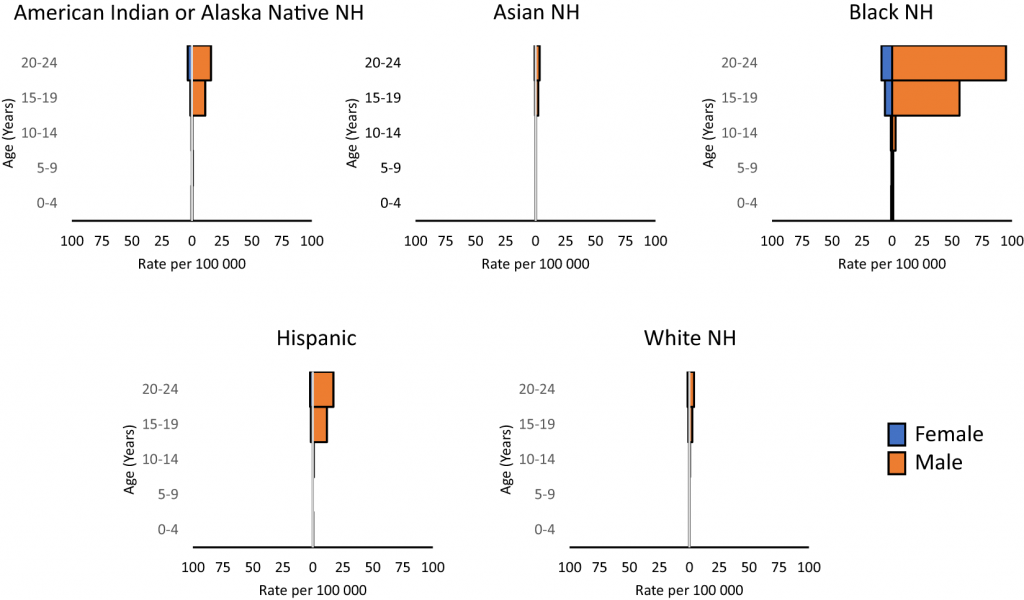
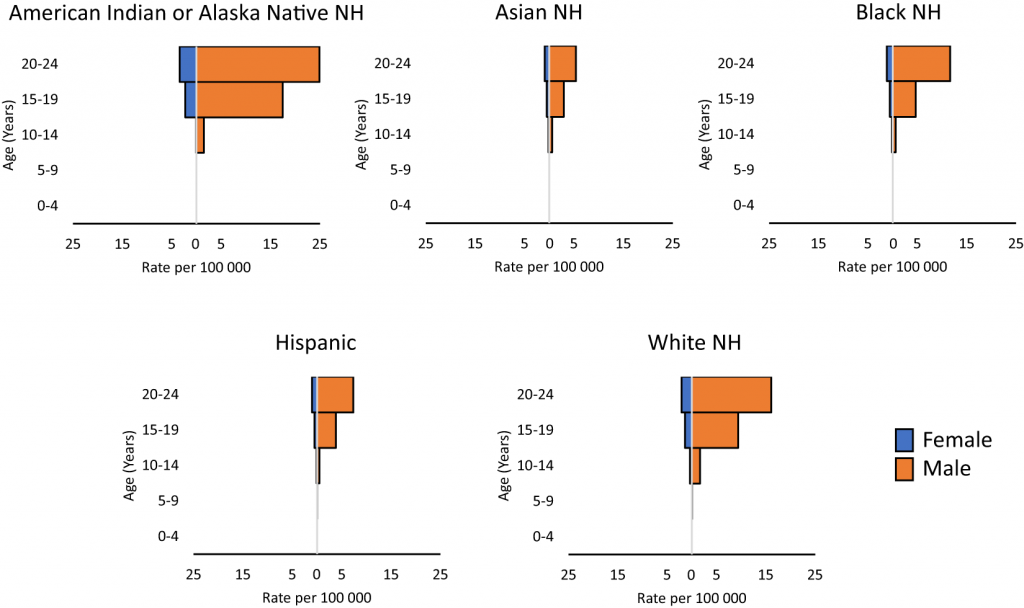
Weird isn’t it? That when people hit that age of self determination, when their minds start developing from child to adult functionality, suddenly those death rates from two motives spike.
The AAP report could easily read ‘Older Teens and Young Adults’ and the title be far more honest. But no, ‘Children’ are what get people paying attention. So pediatricians are not above click baiting and hoping you don’t read beyond the headline too.
How about those unintended deaths, what do those rates look like?

Hmm, ‘unlocked and loaded’ in front of an alleged 4.6 million children does not appear to be the problem they claim. It appears to be several problems in very different scales and that the 4.6 million number is for dramatic effect alone. If we take that number, 4.6 million, and use it to scale each of those death rates up to per million, we get a handful to a few dozen deaths in each demographic which tracks with CDC data.
CDC is showing 694 unintentional deaths due to firearms between 2010 and 2020 for age range 0-14, there are 44,203 deaths for other unintended injury types.
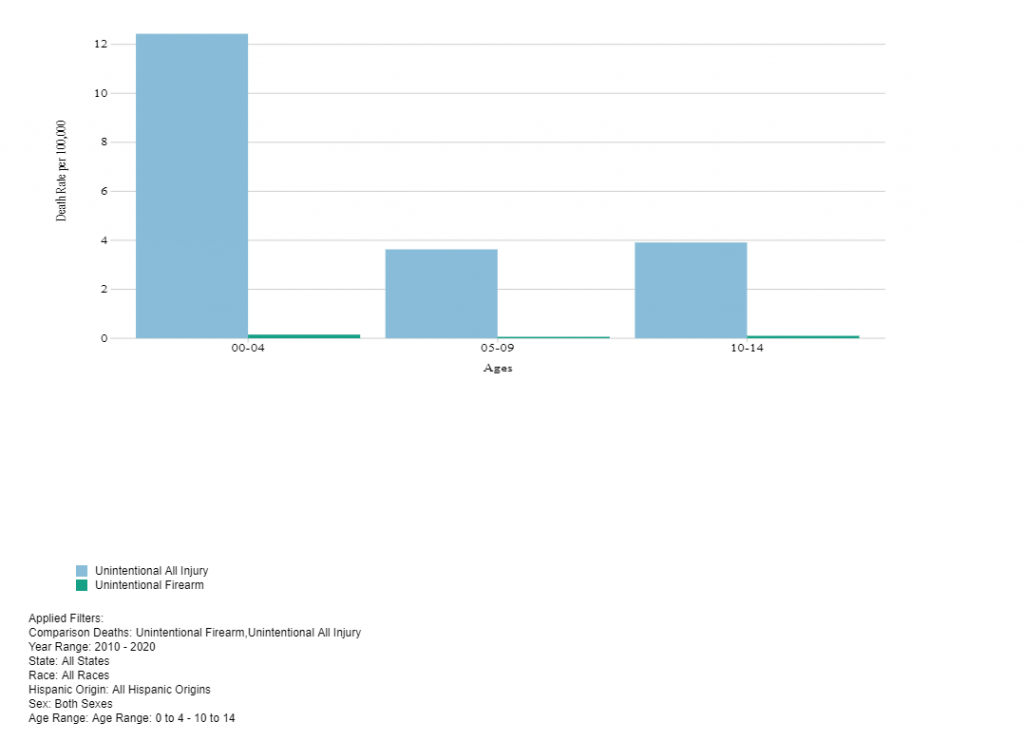
Yes, NPR, we are dealing with several different problems here. Lets stop trying to victim blame those that had their firearms stolen.
3. Ghost guns remain difficult to track and are increasingly used in crime
Privately made firearms, also called “ghost guns,”]
Because scary… Boo. Ghost gun is an entirely fabricated term for propaganda. Also ‘increasingly used’ is an interesting turn of phrase that we will examine below.
[and their involvement in crime “is an emerging issue,” the ATF said in its analysis. Still, law enforcement agencies are just beginning to establish uniform training on how to recognize, identify, and report ghost guns.
Recognize?
They’re kit built firearms with no legal need for a serial number on them, if they were at a crime scene it is equally illegal to crime with a non-serialized firearm as a serialized one. It is equally as felonious to be in possession of a non-serialized firearm as it is a serialized one if you are a felon. Lacking an inventory number does not increase the criminality or risk.
The number of suspected ghost guns recovered by law enforcement agencies and sent to the ATF for tracing and tracking “increased by 1,083% from 2017 (1,629) to 2021 (19,273).” This indicates, for one thing, that these ghost guns are increasingly being used to commit crimes, the ATF concludes.
Kit built guns also wildly increased in popularity during that time period too, but we shouldn’t talk about that I suppose. We could possibly correlate the sudden popularity of a particular item with an increase in its misuse as well, hello Draco AK pistols, now could we?
How does that compare to say… Glocks?
Of the 1,306,804 pistol type crime guns traced between 2017 and 2021, nearly 20% (255,055) were manufactured by Glock –Part III Page 19
And total PMFs?
Of the 37,980 recovered and traced suspected PMFs, pistols accounted for 59% (22,546), rifles accounted for 14% (5,446), machine guns accounted for 12% (4,459), firearm receivers or frames accounted for 4% (1,588), and silencers accounted for 1% (345).
Ah, so Glock alone and all their serial numbers remains over 6 times as problematic as all kit built firearms. How are those serial numbers helping exactly? The common, and serial numbered, handgun remains king of crime at 70% of the traced crime guns in the United States. PMFs, while a problem in isolation, do no represent a significant portion of criminal firearms. Of the 1,922,577 trace requests, only 37,980 (1.97%) were PMFs in the five year timeframe.
But those weapons are tough to track, given that they have no serial numbers or other markings for tracing.
“Those guns are not serialized. Therefore, they’re really attractive to criminals who believe they can escape from accountability for their crimes and who are often not eligible to possess a gun,” Nichols said. “But because these guns are untraceable, they’re able to obtain them pretty easily.”
Let me repeat some hard info for gun controllers.
- Serial numbers aren’t magic. They do not confer GPS data, or user history, or any other of these mythical “trackable” stats that people imply they do. It is an inventory number.
- These weapons do not pose any significantly greater threat than an equivalent serialized weapon in the criminal space, a 9mm handgun is still a 9mm handgun. A 5.56x45mm carbine/pistol/SBR is that level of risk, whether a number exists on the side or not.
- Remember, a completed trace means that they found the 4473 the firearm went out on to an owner, or its theft record, or determined it was a government firearm, and if it got displaced after that the ATF still considers it a complete trace and therefore a successful use of the system. It in no way, shape, or form correlates to the necessity of a trace in solving a crime or completing a prosecution.
- Criminals are able to obtain firearms “pretty easily” full stop. If PMFs were so dramatic a problem in criminal hands and so much easier for them to use, I would expect them to account for more than
So PMFs are a problem, but not a dramatic one. You know what else is a problem? Theft from LEAs, .Gov, and DoD. How many firearms came back as government property in the 5 year timeframe?
25,904.
How many traced guns were simply too old to trace?
65,945.
Guns being old was twice the problem of guns not having a serial number.
How many firearms with serial numbers had it ground off/defaced?
48,601.
So, in summary, firearms being too old were way more of a problem than PMFs. Firearms being modified by removing the serial number were more of a problem than PMFs. Firearms being stolen from the government, who can have machine guns and special ammo and things that we aren’t allowed, were nearly as problematic as PMFs.
So we can stop pretending serialized or non-serialized matters that much. It is a tangential data point. I urge anyone to produce the data were traces were crucial in a criminal prosecution and would have resulted in a criminal walking without it.
I’m having to split this into two parts to break down the full six points, there is a lot to unpack in NPRs oversimplifications and it gets far worse in number 4, so that will start Part 2.
